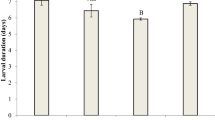Abstract
The use of coccinellids in the biological control of aphids is restricted to the release of larvae because adults tend to fly away. Non-flying adults may stay longer in one place and so they and their progeny could give longer term protection to plants. This work is an attempt to produce a non-flying population by the use of a chemical mutagen and selection of adults with wing malformations through their subsequent generations. These adults are characterized by open elytra and extended wings. Some general features of this mutation were disclosed. The mutation is either unexpressed or results in malformed wings. It also seems recessive and lethal when homozygous. The adults with the mutation suffered a high level of mortality and a drastic reduction in reproductive capacity that prevents their mass rearing for biological control. This study revealed a negative relationship between wing malformations and reproductive capacity. Nevertheless, when adults with the mutation were released in greenhouses containing cucumbers infested with the aphid Aphis gossypii, they remained on the plants in higher numbers and laid eggs over a longer period of time than the control adults but their progeny were less numerous.
Similar content being viewed by others
References
Deng, G.R., H.H. Yang and M.X. Jin, 1987. Augmentation of coccinellid beetles for controlling sugarcane wolly aphid. Chin. J. Biol. Cont. 3: 166–168. (In Chinese, English abstract).
Ettifouri, M. and A. Ferran, 1993. Influence of larval rearing diet on the intensive searching behaviour of Harmonia axyridis larvae. Entomophaga 38: 51–59.
Ferran, A., M.O. Cruz de Boelpepe, L.A. Buscarlet, M.M. Larroque and H. Schanderl, 1984. Les relations trophiques entre les larves de la coccinelle Semiadalia undecimnotata Schn. et le puceron Myzus persicae Sulz.: généralisation à d'autres couples proie-prédateur et influence des conditions d'élevage de l'auxiliaire. Oecol. 5: 85–97.
Ferran, A., P. Gubanti, G. Iperti, A. Migeon and J. Onillon, 1989. La répartition spatiale des différents stades de Coccinella septempunctata dans un champ de blé variation au cours de la saison. Entomol. Exp. Appl. 53: 229–236.
Ferran, A., H. Niknam, F. Kabiri, J.L. Picart, C. De Herce, J. Brun, G. Iperti and L. Lapchin, 1996. The use of Harmonia axyridis larvae (Col., Coccinellidae) against Macrosiphum rosae (Hemiptera, Aphidae) on rose bushes. Eur. J. Entomol. 93: 59–67.
Ghanin, A.A. and M.A. El-Adl, 1991. The role of Coccinella undecimpunctata L. in suppressing the population level of Schizaphis graminum Rond and increase the yield of wheat plantation at Dakalia Governorate, Egypt. Beit. Entomol. 41: 277–286.
Hammond, P., 1985. Dimorphism of wings, wing folding and wing toiletry devices in the ladybird, Rhyzobius litura (F.) (Col., Coccinellidae) with a discussion of interpopulation variation in this and other wing-dimorphic beetle species. Biol. J. Linn. Soc. 24: 15–33.
Hodek, I., 1967. Bionomics and ecology of predaceous Coccinellidae. Ann. Rev. Entomol. 12: 79–104.
Hodek, I., G. Iperti and M. Hodkova, 1993. Long-distance flights in Coccinellidae (Coleoptera). Eur. J. Entomol. 90: 403–414.
Honek, A., 1980. Population dynamics of aphid predators in agroecosystems. In: I. Novák (ed), Proceeding VIII of Czech Plant Protrection Conference, Prague, Research Institute of Plant Production, pp. 299–300.
Honek, A., 1982. The distribution of overwintered Coccinella septempunctata L. (Col., Coccinellidae) adults in agricultural crops. Z. Ang. Entomol. 94: 311–319.
Iperti, G., 1986. Ecobiologie des coccinelles aphidiphages: les migrations. Colloques de l'I. N. R. A. 36: 107–120.
Lapchin, L. and R. Boll, 1996. Modèles de quantification des populations de pucerons en serres de concombres. Service de la Protection des Végétaux, Journées Mutuelles information légumes. Autrans, pp 2.
Majerus, M.E.N. and P. Kearns, 1989. Ladybirds. Richmond Publishing, Slough.
Marples, N.M., P.W. De Jong, M.M. Ottenheim, M.D. Verhoog, and P.M. Brakefield, 1993. The inheritance of a wingless character in the 2 spot ladybird (Adalia bipunctata). Entomol. Exp. Appl. 69: 69–73.
Mordue, A.J. and A. Blackwell, 1985. Azadirachtin: an update. J. Insect. Physiol. 39: 903–924.
Roff, D.A., 1986. The evolution of wing dimorphism in insects. Evolution 40: 1009–1020.
Schanderl, H., A. Ferran and M.M. Larroque, 1985. Les besoins trophiques et thermiques des larves de la coccinelle Harmonia axyridis Pallas. Agronomie 5: 417–421.
Author information
Authors and Affiliations
Rights and permissions
About this article
Cite this article
Ferran, A., Giuge, L., Tourniaire, R. et al. An artificial non-flying mutation to improve the efficiency of the ladybird Harmonia axyridis in biological control of aphids. BioControl 43, 53–64 (1998). https://doi.org/10.1023/A:1009970004842
Issue Date:
DOI: https://doi.org/10.1023/A:1009970004842




